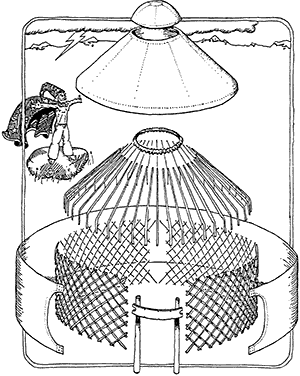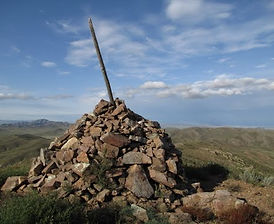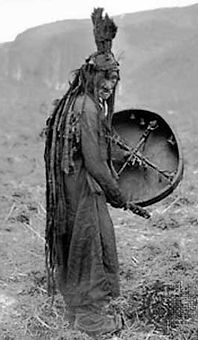Women
Women in this empire still possessed less power than men, but compared to other ancient cultures had a lot more, things they did included: fought, rode horses, helped tend to the different areas of the family, made clothes, took care of animals, cooked, cleaned.There were exeptionally powerful women in the empire, some even became Khans themselves. What they could do depeneded haevily how their nobility of birth.
Children
Mongol children had toys, games, but they did not attend public school, and learned all things from the family. It was important for children to be respectful, behave, and help out with the family
Marriage
Arranged marriage wasn’t uncommon, woman wore different hats based on the fact if they were married or not. If a woman’s husband died she would not remarry, and gained all of his land, and lead the family. It was not uncommon for people from different tribes to wed. It was also not uncommon for them to marry quite young in our eyes.
The Home
Traditional homes within the Mongol Empire were gold ger or yurts. These house were not made to be permanent, since the Mongols generally had a nomadac life styes. They could be assemebled and disassembled quickly in order to move with whatever kind of animals they might be hearding. These houses were in the shap of a dome, and were made out of clothe.
All homes had doors that faced the South, because it was believed that good news came from that direction, and it was considered bad luck to walk counterclockwise in the house. The indside of the houses were genrally smokey because the only release the fire had was through a hole at the top or the door. They did not have windows, and and usaully onsisted of one giant room.
Food
They drank tea with salt, and added (occasionally) : milk, butter, and flour. They used fire stones to cook. Their food depended on where they lived in the Empire. When on the move Mongols would drink a few drops of their horse's blood, and drink mare's milk. Since it was a vast land based empire it is assumed that there would have been different types of cuisine.
They only had two real food groups. White foods were made up a things created from milk. Red foods were any meat that they ate. If they cooked the meet it was either cooked on a spit, or made into soup. They would also add different types of wild vegetables to add to it.
Religion
Generally tolerant of others so that their empire would look more inviting to different religions Here is a quote from Khubilai Khan (he supposedly said this) “There are prophets who are worshipped and to whom everybody does reverence. The Christians say their god was Jesus Christ; the Saracens, Mohammed; the Jews, Moses; and the idolaters Sakamuni Borhan; and I do honor and reverence to all four, that is to him who is the greatest in heaven and more true, and him I pray to help me.” (Genghis Khan himself promoted relgious tolerance). Most people of the Mognol Empire did believe in shamans, and worshipped nature. ("Mongol Empire and Religious Freedom” )
Language
Within Asia all the Mongols shared a common launage. When conquering the different peoples they could easily "mix" them in within the current people of the Mongol Empire. Although, sometimes this was not as easy as it sounds.
Writing
Their writing underwent many changes from the traditional script which kind of sucked for writing, the writing they used until the fall of the empire Phags-pa (created by Drogön Chögyal Phagpa), but was not used by everyone. (Most people in the empire were illterate).
Cultural Overveiw
They were a “nomadic society”, social Classes were divided into two groups: Nobles and Commoners. Made up of lots of different tribes that allied themselves with one another Genghis Khan (Temüjin) wanted to the pull everyone together in order to make a strong empire; Here are some of the different tribes: Merkits, Naimans, Mongols, Keraits, Tatars, and Uyghurs. Theses groups would have been the "true" Mongolian people. The empire itself consisted of all the different peoples that the Mongols conquered throughout the empire's life time. The Mongols were partically good at easing the different cultures of all the conquered people.

Goverment
Their goverment had an elected monarchy. Although only a select few could be arpart of it. Genghis Khan himself instated a group of leaders from each tribe that could help him, and allow those within it to have some sort of input. The first language was also created to help keep records. Though only a select few could actaully read and write.


Modern Oovoos.

20th centraury shaman.

Political Corruption
Like many other civilizations, they expiranced their amount of corrupt goverment. There was a civil war between the brother Kublai and Ariq Boke, who both wanted the title of Great Khan. This woud end in Ariq Boke having all of his warriors killed, and his life spared. It was also believed in the last years of Jöchi was plotting the death of his father, Genghis Khan.
Currency
Depending on where you were in the empire money varied. In 1273 Kublai Khan created a system of paper money, chao, which eased the process of making it. It helped the bank of the empire, since it was easier to use and produce.
Clothing
Like most of the empire where you lived determined how you lived. Clothing is not exception. Although in the traditional Mongol Homeland. What you wore depended on what you were. It was common though for everyone to wear a" deel robe, a sort of overcoat, including a sash that wrapped around the waste.
They varied for the different genders, depending on how active they were. But women constantly wore long ones. There were also some for the different seasons. Each consisting of different material geared toward making it comfortable for it's appriate season.
Hats were also important to the Mongols. Every clan had their own specific one. It was not uncommon to wear special, and decorated hats during certain celebrations. (Mongols: Clothes for a Rough, Active Life in the Cold)
Social Structure
The social structure of the Mongol Empire varied during the different time periods of the empire. During the Yuan dynasty the Mongols were at the top of the social hierachy, muslims were next, and the rest were below them. ("The Yuan Dynasty")
In the traditional Mongol society there were nobles and commoners. Each tribe had a cheiftan.
Inside Structure of a Home
Work Cited:
“Cultural Geography.” Amy S. Glenn. Amy S. Glenn, 03 May 2015. Web. 11 May 2015.
“Mongols: Clothes for a Rough, Active Life in the Cold.” History on the Net. HistoryOnTheNet, 08 Sept. 2014. Web. 13 May 2015.
“Mongol Empire and Religious Freedom.” History on the Net. HistoryOnTheNet, 08 Sept. 2014. Web. 08 May 2015.
“Mongolian (монгол).” Omniglot. Simon Ager. n.d. Web. 18 Apr. 2015
“Mongol Society: Women, Men and Children.” History on the Net. HistoryOnTheNet, 08 Sept. 2014. Web. 17 Apr. 2015
“Mongols: Their Empire, Religion, Horses, and Family Life.” Facts and Details. Jeffrey Hays. n.d. Web. 08 May 2015.
“Poisuo, Pauli. “The Mongols.” Listverse. Listverse Ltd, 10 Oct. 2013. Web. 18 Apr. 2015.
“Kublai Khan Timeline.” SoftSchools.com. SoftSchools.com, n.d. Web. 11 May 2015.
“The Gifts of Government.” Genghis Khan. The Field Museum, n.d. Web. 09 May 2015
"Editors of Encyclopædia Britannica. “Jöchi Mongol Prince.” Encyclopaedia Britannica. Encyclopædia Britannica, Inc., n.d. Web. 10 May 2015.
“The Yuan Dynasty.” China Highlights. China Highlights, n.d. Web. 13 May 2015.
“What Did the Mongols Eat?” History on the Net, HistoryOnTheNet, 08 Sept. 2014. Web. 14 May 2015.
“What Made the Mongol Army so Successful?” History on the Net. HistoryOnTheNet, 09 Sept. 2014. Web. 14 May 2015.